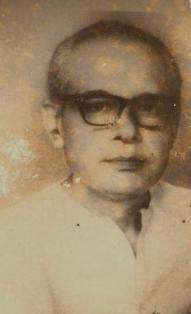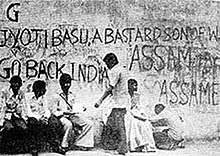Bongal Kheda
Bongal Kheda is the name given to a set of activities against the Bengali Hindus in undivided Assam in the late 1940s that continued into the 1960s.[1] Significant property damage, ethnic policing and even instances of street violence occurred throughout the region.[2] During its peak in 1960, a large number of Bengali Hindus left Assam and took shelter in West Bengal. Robin Dey, the Bengali-born creator of teenage adventure series of Dasyu Bhaskar in Assam was forced to leave Assam and settle in Kolkata.[3] In 1959, Sukomal Purakayastha, who was later martyred during the Bengali Language Movement in 1961, was forced to wind up his business in Dibrugarh and flee to Barak Valley.[4]
Background

The concern for rapidly increasing amount of refugees arriving from East Bengal and later newly formed East Pakistan in the 1940s, created tension among the Indigenous Assamese people and many tribes in the state.[5] The first influx of Hindu refugees in considerable number was in October 1946 following the Noakhali riots.[6] By May 1949 the number of total refugees reached two-and-half lakhs increasing up to 2, 740, 455.[7] In May 1948, ethnic tension escalated between the Assamese people and the Bengali Hindus in the Paan bazaar area of Guwahati, which soon spread to different parts of Assam.[8] Bengali-owned shops were looted in Guwahati. Abusive wall graffiti were put out across the streets of Guwahati such as "Who ate all the fish?, the Bengalis ! So out with them."[9] In 1956, there were widespread disturbances in the erstwhile undivided Goalpara district, when the States Reorganization Commission visited the district to ascertain the feasibility of the district's merger with West Bengal. Sarat Chandra Sinha, the Congress MLA who would later be the Chief minister of Assam, is known to have rallied in different parts of Goalpara district and made provocative speeches against the Bengali Hindus, instigating mob violence against them.[9] Around 250 Bengali medium schools were converted to Assamese medium schools overnight. As per a letter by PM Jawaharlal Nehru to the Assam government, at least one Bengali Hindu was stabbed.[10]
| Place of Origin | Year | Number |
|---|---|---|
| East Bengal | 1946 | 8,593 |
| East Bengal | 1947 | 42,346 |
| East Bengal | 1948 | 41,740 |
| East Bengal | 1949 | 33,138 |
| East Bengal | 1950 | 1,44,51− |
| East Bengal | 1950 (Jan.&Feb.) | 3,479 |
| West Pakistan | - | 647 |
| Total | 2,74,455 |
Attacks

The attacks on the Bengali Hindus started in June 1960. It first started at the Cotton College in Guwahati and then spread to the rest of the state.[12] Assamese mob attacked Bengali Hindu settlements in the Brahmaputra Valley.[9] Violence took place in 25 villages of Goreswar in Kamrup district. A one-man enquiry commission was set up under Justice Gopal Mehrotra. According to the report nine Bengali were killed and more than one hundred were injured. There was at least one incident of attack on women. 4,019 huts and 58 houses belonging to the Bengalis were vandalised and destroyed. The District Magistrate of Guwahati who happened to be a Bengali Hindu was attacked by a mob of around 100 people inside his residence and stabbed.[13] The Deputy Inspector General of Police, also a Bengali Hindu was also stabbed.[13] The Bengali students of Guwahati University, Dibrugarh Medical College and Assam Medical College were forcibly expelled from the institutions.[14] In Dibrugarh, the Bengali Hindus were attacked in the mixed localities. Bengali Hindu houses were looted, burnt and the occupants were beaten up, knifed and driven out.[12]
Displacement
Thousands of Bengali Hindus were displaced from the Brahmaputra Valley and they subsequently migrated to West Bengal. According to one estimate 500,000 Bengalis were displaced from Assam.[15] In West Bengal, thousands of refugees arrived in phases. The first batch of around 4,000 refugees arrived between 5 and 11 July 1960. The next batch of 447 arrived between 12 and 20 July. The rest arrived after 31 July. During July – September, around 50,000 Bengalis took shelter in West Bengal.
| Cumulative refugee figures from Assam in Jalpaiguri district, West Bengal | |||||||
| Date | Cumulative figures | ||||||
|---|---|---|---|---|---|---|---|
| 16 July 1960 | 9,365 | ||||||
| 1 August 1960 | 8,975 | ||||||
| 21 August 1960 | 10,043 | ||||||
| 25 August 1960 | 50,000 | ||||||
Protests
In 1962, Bengali folk poet Nibaran Pandit composed a collection of poems Sei Dingulir Katha (meaning 'the tales of those dark days') in protest of the Bongal Kheda movement.[16]
Aftermath
1960 Language riots
In 1960, large scale ethnic riots erupted in Assam again when Assamese groups demanded for making Assamese the sole language for writing examinations under the prestigious Gauhati university, where as usual the Bengali Hindus were mostly targeted. This time the violence remained concentrated mostly in the lower Assam districts with minor outbreaks reported in Sibsagar and Dibrugarh.[17] Around 14,000 Bengali Hindus fled to West Bengal and elsewhere in the North East.
1979-80 attacks

During the first phase of the Assam Agitation, Bengali settlements were attacked throughout the Brahmaputra Valley. The killing of Rabi Mitra, an ethnic Bengali technical officer at Oil India's headquarters in Duliajan caused widespread panic among the Bengalis. In 1983, the Bengali Hindus were attacked again during the anti-foreign agitation. In Dhemaji district, the Bengali houses were vandalised by rioting Assamese mobs in Silapathar. Cases have been reported when tribals (Mishing people) were instigated to attack government sanctioned Bengali Hindu refugee settlements in the Lakhimpur district, resulting in horrendous massacres where Bengali babies were snatched from their mothers and thrown to fire, alive. Extremely abusive graffiti targeting Bengali Hindus became a common hate spreading mechanism for the Assamese rioters. "If you see a snake and a Bengali, kill the Bengali first", "Assam for Assamese", etc. were easily seen written on the graffitied walls across the Brahmaputra valley.[18] The Khasi tribals of Meghalaya, under the banner of Khasi Students Union (KSU) and under active collaboration and patronage of the Assamese rioters started targeting domicile Bengalis in Meghalaya, resenting their dominance in jobs and business. The attacks mostly restricted to Shillong. In 1980, a Bengali legislator was killed and the Bengali localities came under systematic attack repeatedly. Gauri Dey, a pregnant Bengali Hindu women was gang-raped by a Khasi mob in front of her husband and then tied to a tree and lynched. The attacks took place mostly before Durga Puja, the most important Bengali Hindu festival. An estimated 25,000 to 35,000 Bengalis left Meghalaya and settled in West Bengal and other parts of India, since the 1980s.
References
- Karmakar, Rahul (27 September 2017). "That Rohingya feeling: NE no stranger to xenophobia, genocides, say experts". Hindustan Times. HT Media. Retrieved 15 October 2017.
- Bijay Kumar, Dhar (31 July 2015). "এনআরসি আরও একটি পৃথক রাজ্যের দাবিকে উস্কে না দেয়". Anandabazar Patrika (in Bengali). Kolkata: ABP Group. Retrieved 19 October 2018.
- Ray, Biswajit (21 February 2014). "বাংলার বাইরে বাংলার খোঁজে কয়েক দিন". Anandabazar Patrika (in Bengali). Kolkata: ABP Group. Retrieved 26 June 2017.
- "তোমরা ছিলে তাই লেখার সাহস পাই". Ei Samay (in Bengali). Kolkata: Bennett Coleman. 19 May 2015. Retrieved 26 June 2017.
- "Illegal Migration into Assam". www.satp.org. Retrieved 6 July 2019.
- "Wayback Machine" (PDF). 16 October 2017. Archived from the original (PDF) on 16 October 2017. Retrieved 6 July 2019.
- Census of India, 1951, Vol. XII, Part I (I-A), 353.
- Nag, Sajal (2015). Nehru and the North East (PDF). p. 12. ISBN 978-93-83650-81-1. Archived from the original (PDF) on 16 October 2017. Retrieved 15 October 2017.
- Internal Displacement in South Asia: The Relevance of the UN's Guiding Principles. Sage. 2005. pp. 150–151. ISBN 0761933131.
- Bhattacharya, Nitish (25 July 2015). "অসম বাংলাভাষীরও, বুঝতে হবে শাসকদের". Anandabazar Patrika (in Bengali). Kolkata: ABP Group. Retrieved 26 June 2017.
- India, Census of (1951). "Annual Arrival of Refugees in Assam in 1946–1951". Census of India. XII, Part I (I-A): 353 – via web.archive.org.
- Datta, Rathin. "A Taste of British Judiciary & infamous 'Bongal Kheda'". TripuraINFOWAY.com. Tripura Infoway News. Retrieved 15 October 2017.
- Chakravarti, K.C. (30 July 1960). "Bongal Kheda Again" (PDF). The Economic Weekly. Mumbai: Sameeksha Trust: 1193–95. ISSN 0012-9976. Retrieved 5 March 2014.
- Chowdhury, Anwar (19 February 2016). "যে আগুন ছড়িয়ে গেল..." Daily Ittefaq (in Bengali). Dhaka. Retrieved 26 June 2017.
- Bhaumik, Subir (2008). Samir Kumar Das (ed.). Blisters on their Feet (PDF). Sage. p. 303. ISBN 978-81-7829-819-1. Archived from the original (PDF) on 5 March 2014. Retrieved 5 March 2014.
- "কবি নিবারণ পণ্ডিত". Milansagar (in Bengali). Retrieved 26 June 2017.
- Sekhawat, Vibhuti Singh (2007). Assam: From Accord to ULFA. Anamika Publishers. p. 88. ISBN 9788179751695. Retrieved 6 March 2014.
- 'Bearing Witness': The Impact of Conflict on Women in Nagaland and Assam. Centre for North East Studies and Policy Research. 2011. p. 42.